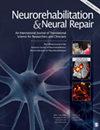Assessing Impairments in Visuomotor Adaptation After Stroke
IF 3.7
2区 医学
Q1 CLINICAL NEUROLOGY
引用次数: 4
Abstract
Background: Motor impairment in the arms is common after stroke and many individuals participate in therapy to improve function. It is assumed that individuals with stroke can adapt and improve their movements using feedback that arises from movement or is provided by a therapist. Here we investigated visuomotor adaptation in individuals with sub-acute and chronic stroke. Objective: We examined the impact of the stroke-affected arm (dominant or non-dominant), time post-stroke, and relationships with clinical measures of motor impairment and functional independence. Methods: Participants performed reaching movements with their arm supported in a robotic exoskeleton. We rotated the relationship between the motion of the participant’s hand and a feedback cursor displayed in their workspace. Outcome measures included the amount that participants adapted their arm movements and the number of trials they required to adapt. Results: Participants with stroke (n = 36) adapted less and required more trials to adapt than controls (n = 29). Stroke affecting the dominant arm impaired the amount of adaptation more than stroke affecting the non-dominant arm. Overall, 53% of participants with stroke were impaired in one or more measures of visuomotor adaptation. Initial adaptation was weakly correlated with time post-stroke, and the amount of adaptation correlated moderately with clinical measures of motor impairment and functional independence. Conclusion: Our findings reveal impairments in visuomotor adaptation that are associated with motor impairment and function after stroke. Longitudinal studies are needed to understand the relationship between adaptation and recovery attained in a therapy setting.评估脑卒中后视觉运动适应的损害
背景:中风后手臂运动障碍很常见,许多个体参与治疗以改善功能。人们认为中风患者可以通过运动或治疗师提供的反馈来适应和改善他们的运动。在这里,我们研究了亚急性和慢性中风患者的视觉运动适应。目的:我们研究了卒中影响臂(显性或非显性)的影响,卒中后时间,以及与运动损伤和功能独立性的临床测量的关系。方法:参与者用机械外骨骼支撑手臂进行伸展运动。我们旋转了参与者的手的运动和他们工作空间中显示的反馈光标之间的关系。结果测量包括参与者适应手臂运动的数量和他们需要适应的试验次数。结果:与对照组(n = 29)相比,卒中患者(n = 36)适应更少,需要更多的试验来适应。影响优势臂的中风比影响非优势臂的中风对适应能力的损害更大。总体而言,53%的中风患者在一项或多项视觉运动适应测量中受损。初始适应与脑卒中后时间呈弱相关,适应量与运动损伤和功能独立性的临床指标呈中度相关。结论:我们的研究结果揭示了卒中后视觉运动适应障碍与运动障碍和功能相关。需要进行纵向研究,以了解在治疗环境中适应和恢复之间的关系。
本文章由计算机程序翻译,如有差异,请以英文原文为准。
求助全文
约1分钟内获得全文
求助全文
来源期刊
CiteScore
8.30
自引率
4.80%
发文量
52
审稿时长
6-12 weeks
期刊介绍:
Neurorehabilitation & Neural Repair (NNR) offers innovative and reliable reports relevant to functional recovery from neural injury and long term neurologic care. The journal''s unique focus is evidence-based basic and clinical practice and research. NNR deals with the management and fundamental mechanisms of functional recovery from conditions such as stroke, multiple sclerosis, Alzheimer''s disease, brain and spinal cord injuries, and peripheral nerve injuries.

 求助内容:
求助内容: 应助结果提醒方式:
应助结果提醒方式:


